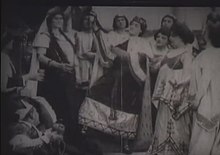The Winter's Tale (1910 film)
| The Winter's Tale | |
|---|---|
 A frame from the film | |
| Directed by | Barry O'Neil or Lloyd B. Carleton |
| Produced by | Thanhouser Company |
Release date |
|
Running time | 12 minutes, 35 seconds |
| Country | United States |
| Languages | Silent film English inter-titles |
The Winter's Tale is a 1910 American
Plot
The film is a shortened single reel adaption of the play The Winter's Tale by William Shakespeare. The film opens with the meeting of the kings of Bohemia and Sicilia. Hermione, the queen of Sicilia, entertains Polixenes, king of Bohemia. This arouses jealousy in Leontes, the king of Sicilia. Leontes decides to poison Polixenes and orders a courtier to carry out the task. The courtier slips the poison into the cup, but he changes his mind and confesses to the murderous plot. Polixenes and the courtier depart safely, but this enrages the Leontes, who has his wife imprisoned. In prison, Hermione gives birth to a daughter and sends it to her husband, hoping to quell his anger. This further upsets Leontes and he orders the child to be taken out to the wilderness to die. Hermione is then brought before a tribunal, swoons, and is pronounced dead by Paulina.[1]
In a departure from the play, the film shows Hermoine's revival and departure to Paulina's house to dwell in seclusion. The infant princess is raised up by a shepherd of Bohemia. After a time lapse of 15 years, Polixenes confronts his son over his wanderings. He refuses to answer and the king follows him in secret. The prince, disguised as a shepherd, woos the young shepherdess and announces his intention to marry her. The king arrives and forbids it, but a faithful courtier advises them to seek protection of the king of Sicilia. Leontes has long mourned and come to regret his past actions. There, the identity that the shepherdess as his daughter is revealed and the marriage is approved. The royal party is invited to Paulina's house to view a statue of the late queen Hermoine. At the party, Hermoine disguised as a statue, extend her hand and surprises the grieving Leontes, who then rejoices.[1]
Cast
- Anna Rosemond as the Queen of Sicilia[1]
- Martin Faust as the King of Sicilia[1]
- Frank H. Crane as the King of Bohemia[1]
- Amelia Barleon as the Princess of Sicilia[1]
- Alfred Hanlon as the Prince of Bohemia[1]
Production
The adaptation of the scenario is credited to
The Thanhouser adaption notably foregoes the famous Shakespearean stage directions: Exit, pursued by a bear. and allows Antigonus a peaceful exit. Another difference in the production is that following the collapse and reported death of Hermione. In the play, the audience is aligns with Leontes' view and gives no reason to doubt Hermione's death, but the Thanhouser adaptation shows the mechanism and conspiracy formed by showing Hermione's revival and departure. Instead of using the Shakespeare character of Time to frame the passage of time, the role is performed by an inter-title. The final scene is missing from the surviving print.[5]
Release and reception
The one reel drama, approximately 1000 feet long, was released on May 27, 1910.[1] The surviving fragment in the Library of Congress is 12 minutes 35 seconds long, but it does not include the final scene with the disguised Queen of Sicilia.[2][5] The surviving fragment has suffered significant damage due to deterioration.[2] The film was re-released by the Thanhouser Company Film Preservation with a new original score composed and performed by Raymond A. Brubacher.[2]
The film was positively reviewed by the contemporary trade publications that garnered almost universal acclaim.
A modern review was given by University of York Professor Judith Buchanan. Buchanan recognizes that the film's acting was commended for its action and highlights the acting of the fool, placed prominently in the foreground, and says that it seems as if he has been imported from King Lear. This fool serves as an exaggerated proxy for the audience and filters a set of responses for the audience and goes on to steal the reunion scene with his expressions. Buchanan says that adapting the Shakespeare play to the one reel format required foreknowledge of the subject for audiences to intelligibly follow the subject. Buchanan also notes that this transitional period included lecturers who were hired to give supplementary lectures or commentary on the film being exhibited and the additional commentary for Shakespeare adaptations was desirable.[5]
See also
References
- ^ a b c d e f g h i j k Q. David Bowers (1995). "Volume 2: Filmography - The Winter's Tale". Thanhouser.org. Retrieved January 30, 2015.
- ^ a b c d "The Winter's Tale". Thanhouser.org. Retrieved January 30, 2015.
- ^ a b Q. David Bowers (1995). "Volume 1: Narrative History - Chapter 3 - 1910: Film Production Begins". Thanhouser.org. Retrieved January 19, 2015.
- ^ Q. David Bowers (1995). "Volume 2: Filmography - Her Battle for Existence". Thanhouser.org. Retrieved January 20, 2015.
- ^ a b c The Winter's Tale (1910) with Judith Buchanan commentary. Thanhouser.org.
External links
- The Winter's Tale at IMDb
